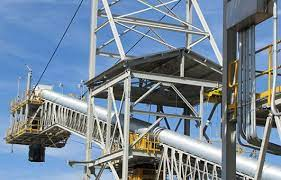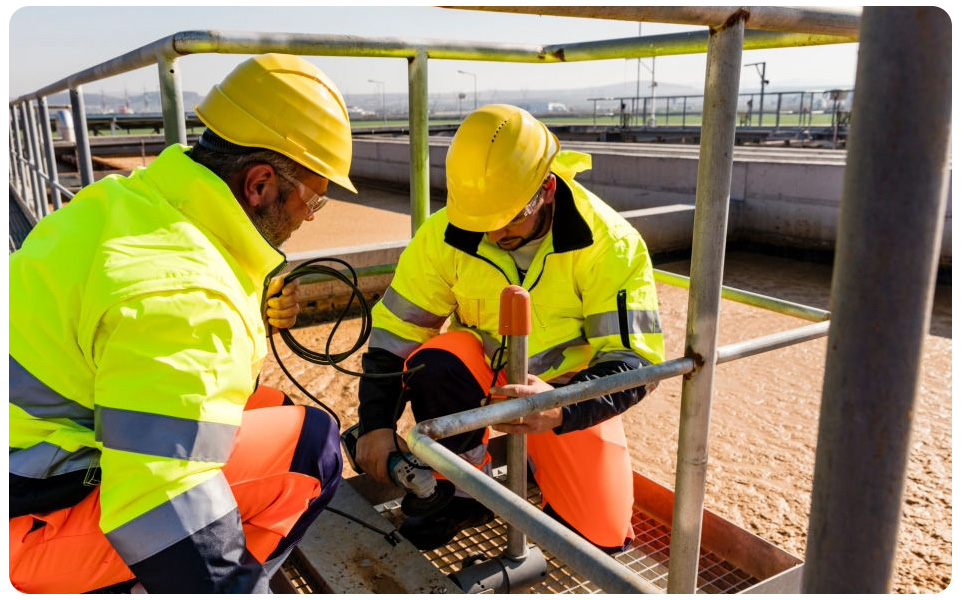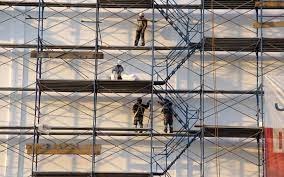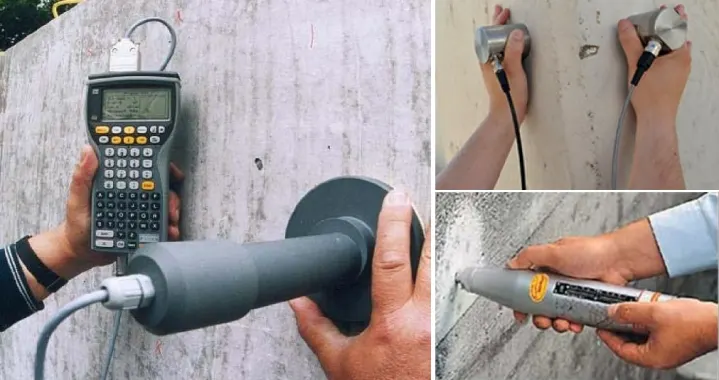Foreman Erection (6 Month course)
Foreman Erection click hare
Brief Job Description: Foreman Erection is responsible for determining feasibility of
heavy lifting operation at construction sites by inspecting lifting equipment, lifting
locations and allocating manpower. Individuals in this job role execute heavy lifting by
ensuring safe condition of rigging gears/ tools used for the job and providing signals to

the lifting equipment operator for appropriate handling and placing of heavy load to
desired location as per work plan. The job role is also responsible for erection of
structural steel/ RCC precast units as per drawing and implementation of safety norms
as applicable to heavy lifting and erection operations.
Personal Attributes: This job role requires the individual to be physically and mentally
fit to act as a head of a crew of riggers executing heavy lifting and erection works at
construction sites. The individual should be having considerable domain expertise and
factual knowledge in order to plan, organize sequence activities and allocate resources
according to the work requirement. The job holder should preferably be free from
vertigo problem, cardiovascular diseases as the nature of work involves handling heavy
loads and working at heights
Description
Sector Sector is conglomeration of different business operations having similar
business and interests. It may also be defined as a distinct subset of the
economy whose components share similar characteristics and interests.
Sub‐Sector Sub‐Sector is derived from a further breakdown based on the characteristics
and interests of its components
Occupation Occupation is a set of job roles, which perform similar/related set of
functions in an industry
Job role Job role defines a unique set of functions that together form a unique
employment opportunity in an organization.
Occupational Standards
(OS)
OS specify the standards of performance an individual must achieve when
carrying out a function in the workplace, together with the knowledge and
understanding they need to meet the standard consistently. Occupational
Standards are applicable both in the Indian contexts.
Performance Criteria Performance Criteria are statements that together specify the standard of
performance required when carrying out a task.

Qualifications Pack (QP) Qualifications Pack comprises the set of OS, together with the educational,
training and other criteria required to perform a job role. A Qualification Pack
is assigned a unique qualification pack code
Qualification Pack Code Qualification Pack Code is a unique reference code that identifies a
qualifications pack.
National Occupational
Standards (NOS) NOS are Occupational Standards which apply uniquely in the Indian context.
Scope Scope is the set of statements specifying the range of variables that an
individual may have to deal with in carrying out the function which have a
critical impact on the quality of performance required.
Knowledge and
Understanding
Knowledge and Understanding are statements which together specify the
technical, generic, professional and organizational specific knowledge that an
individual needs in order to perform to the required standard.
Organizational Context Organizational Context includes the way the organization is structured and
how it operates, including the extent of operative knowledge managers have
of their relevant areas of responsibility.
Technical Knowledge Technical Knowledge is the specific knowledge needed to accomplish specific
designated responsibilities.
Core Skills / Generic Skills Core Skills or Generic Skills are a group of skills that are key to learning and
working in today’s world. These skills are typically needed in any work
environment. In the context of the OS, these include communication related
skills that are applicable to most job roles.
Keywords /Terms Description
CON Construction
NSQF National Skill Qualifications Framework
QP Qualification Pack
OS Occupational Standards
TBD To Be Decided
Inspect and ensure feasibility of lifting operation
Description This unit describes the skills and knowledge required to inspect and ensure
feasibility of lifting operation.
Scope The scope covers the following:
Check and ensure safe working of equipments used for erection
Check the work area and ensure suitable condition for heavy load lifting and
erection
Performance Criteria (PC) w.r.t. the Scope
Element Performance Criteria
Check and ensure
safe working of
equipments used for
erection
To be competent, the user / individual on the job must be able to:
PC1. carry out inspection to the equipments visually or by conducting trial runs
PC2. check all certificates relevant to safe working of the lifting equipments
PC3. check counterweight attached to the equipment is as per specification and
work requirement

PC4. check fuel requirement of equipments prior to lifting and report to
concerned authority in case of insufficiency
PC5. carry out functional test of the emergency stop device
PC6. report for maintenance to the equipments to superior on break down or
malfunction
PC7. fill up necessary checklists (if any) relevant to equipment fitness prior to
lifting
Check the work area
and ensure suitable
condition for heavy
load lifting and
erection
PC8. ensure adequate compaction and base of base of lifting equipment’s
PC9. ensure area of operation (lifting, unloading and erection) is safely marked,
barricaded, accessed and free from other hazardous effects
PC10. check the foundations or supports are adequately stable and completed in
essential aspects to bear the load of erection to commence
PC11. instruct workers to use appropriate PPEs during activities
PC12. instruct subordinates to carry out checks to the lifting tools and tackles to
ensure safe working
PC13. coordinate with equipment operators to assess feasibility of operation which
includes safe wind speed, clear visibility, required clear area for swing of
boom, clear access to the unloading location
Knowledge and Understanding (K)
A. Organizational
Context
(Knowledge of
the company / organization and
its processes)
Inspect and ensure feasibility of lifting operation
Description This unit describes the skills and knowledge required to inspect and ensure
feasibility of lifting operation.
Scope The scope covers the following:
Check and ensure safe working of equipments used for erection
Check the work area and ensure suitable condition for heavy load lifting and
erection
Performance Criteria (PC) w.r.t. the Scope
Element Performance Criteria
Check and ensure
safe working of
equipments used for
erection
To be competent, the user / individual on the job must be able to:
PC1. carry out inspection to the equipments visually or by conducting trial runs
PC2. check all certificates relevant to safe working of the lifting equipments
PC3. check counterweight attached to the equipment is as per specification and
work requirement

PC4. check fuel requirement of equipments prior to lifting and report to
concerned authority in case of insufficiency
PC5. carry out functional test of the emergency stop device
PC6. report for maintenance to the equipments to superior on break down or
malfunction
PC7. fill up necessary checklists (if any) relevant to equipment fitness prior to
lifting
Check the work area
and ensure suitable
condition for heavy
load liftin
g and
erection
PC8. ensure adequate compaction and base of base of lifting equipment’s
PC9. ensure area of operation (lifting, unloading and erection) is safely marked,
barricaded, accessed and free from other hazardous effects
PC10. check the foundations or supports are adequately stable and completed in
essential aspects to bear the load of erection to commence
PC11. instruct workers to use appropriate PPEs during activities
PC12. instruct subordinates to carry out checks to the lifting tools and tackles to
ensure safe working
PC13. coordinate with equipment operators to assess feasibility of operation which
includes safe wind speed, clear visibility, required clear area for swing of
boom, clear access to the unloading location
Knowledge and Understanding (K)
A. Organizational
Context
(Knowledge of
the company /
organization and
its processes)
The user/individual on the job needs to know and understand:
KA1. standard practices for rigging work
KA2. safety rules and regulations for handling and storing required tools,
equipments and materials for rigging works
The user/individual on the job needs to know and understand:
KA1. standard practices for rigging work
KA2. safety rules and regulations for handling and storing required tools,
equipment’s and materials for rigging works
KA3. personal protection including the use of the related safety gears and
equipment
KA4. service request procedures for tools, materials and equipments
KA5. statutory compliance requirements related to working at height
KA6. statutory compliance requirement related to workmen engagement
B. Technical
Knowledge
The user/individual on the job needs to know and understand:
KB1. how to read and interpret drawings, specifications relevant to task
KB2. basic computer literacy
KB3. working mechanism of heavy lifting equipments like cranes, jacks, winches,
derricks

KB4. common checks to be carried out the lifting equipment and its components/
accessories to determine its fitness for working
KB5. load lifting capacity of lifting equipments under use and interpretation load
chart provided with concerned equipments
KB6. statutory requirements of lifting equipments and its operators for safe
working at construction sites
KB7. how to place counterweights to the lifting equipments as per equipment
manual/ guidelines/ load lifting requirement
KB8. preparatory works to be completed for using heavy lift equipments like area
grading, base compaction, periodical maintenance
KB9. common hazards involved in heavy lifting and erection work
KB10.factors having influence in lifting and erection work like wind speed,
visibility, shape and weight of object being lifted, presence of obstruction,
counter weight etc.
KB11.approved work method statement, applicable safety norms and safety
control measures as applicable to the heavy lifting/ erection works at site
Skills (S)
A. Core Skills/
Generic Skills
Writing Skills
The user/ individual on the job needs to know and understand how to:
SA1. write in at least two language, preferably in the local language of the site and
basic English
SA2. provide clear and simple instructions, details & sketches to sub-ordinate
SA3. record and documents daily productivity report, daily labor attendance &
details regarding work
SA4. prepare basic status updates for the superiors in the prescribed format
Reading Skills
The user/ individual on the job needs to know and understand how to:
SA5. read one or more language, preferably in the local language of the site
SA6. read drawing, rigging specification and standards
SA7. read key documents including quality standards, standards working methods & applicable tolerance limits
SA8. read various, sign boards, safety rules and safety tags , instructions related to
exit routes during emergency at the workplace
Oral Communication (Listening and Speaking skills)
The user/ individual on the job needs to know and understand how to:
SA9. speak in one or more language, preferably in one of the local languages of
the site
SA10. listen and follow instructions clearly given by the superior
SA11. provide clear instructions to subordinates for completion of task as per work
plan, time schedule and quality
A. Professional
Skills
Decision Making
The user/individual on the job needs to know and understand how to:
SB1. estimate required material and resources for work
SB2. decide alternate course of action in case of hindrance to work
SB3. decide whether the counterweight attached to the equipment is as per
specification and work requirement
Plan and Organize
The user/individual on the job needs to know and understand how to:
SB4. plan work & organize required resource in coordination with team members
and superior
SB5. plan work targets, allocate time schedule to sub-ordinates and organize
completion of task within allocated time

Customer centricity
The user/individual on the job needs to know and understand how to:
SB6. ensure completion of work as per agreed time schedule and quality
Problem solving
The user/individual on the job needs to know and understand how to:
SB7. report to superior for maintenance to the equipment’s on break down or
malfunction
SB8. resolve and solve any conflict within the team
Analytical Thinking
The user/individual on the job needs to know and understand how to:
SB9. assess quantity of materials for day work
SB10. optimize resources
SB11. minimize wastages
Critical Thinking
The user/individual on the job needs to know and understand how to:
SB12. assess complexity of the tasks and provide guidance for carrying out
corrective action as per requirement
SB13. identify and assess how violation of any safety norms may lead to accidents
Supervise heavy lifting of structural assemblies at construction sites
Description This unit describes the skills and knowledge required to supervise heavy lifting of
structural assemblies at construction sites.
Scope The scope covers the following:
Supervise heavy lifting activity
Provide signals to equipment operator by hand or using electronic devices

Performance Criteria (PC) w.r.t. the Scope
Element Performance Criteria
Supervise heavy
lifting activity
To be competent, the user/individual on the job must be able to:
PC1. brief subordinates about heavy lifting plan and safety control measures prior
to start lifting
PC2. allocate activities to specified subordinates as per their level of expertise
PC3. analyze hazards related with lifting operations and report to concerned
authority for any required action
PC4. ensure safe and desired functioning of lifting equipments by conducting
checks to the equipments and trial run by competent personnel
PC5. carry out physical checks on components, assemblies and its locations where
sling is to be attached for lifting
PC6. check slinging tools, lifting tools for their usability and specification according
to load
PC7. ensure tightening of shackles, hooks, anchoring slings or belts during lifting
of load
PC8. ensure exact locking of sling at hook of crane
PC9. ensure use of tag line of adequate length to control motion of the suspended
load
PC10. ensure motion of crane boom and load movement path is free from any
static or mobile obstruction, adequately illuminated
PC11. check and ensure erection of barricading surrounding heavy lifting location
Provide signals to
equipment operator
by hand or using
electronic devices
PC12.maintain clear line of vision with the operator and suspended load while
providing signal
PC13.operate communication devices efficiently
PC14.provide verbal directions appropriately to equipment operator using
communication devices
PC15. adhere to standard hand signal methods while providing signals
PC16.provide signals to guide suspended loads to appropriate location under
critical conditions such as in case of obstacles, imperceptible erection spots,
dimly lighted conditions
Knowledge and Understanding (K)
A. Organizational
Context
(Knowledge of
the company /
organization and
its processes)
The user/individual on the job needs to know and understand:
KA1. standard practices for rigging work
KA2. safety rules and regulations for handling and storing required tools,
equipments and materials for rigging works
KA3. personal protection including the use of the related safety gears and
equipment
KA4. service request procedures for tools, materials and equipments
KA5. statutory compliance requirements related to working at height
KA6. statutory compliance requirement related to workmen engagement
B. Technical
Knowledge
The user/individual on the job needs to know and understand:
KB1. how to read and interpret drawing, specification relevant to task
KB2. agreed lifting plan and schedule to be adhered during lifting operation
KB3. working mechanism of heavy lifting equipments like cranes, jacks, winches,
derricks
KB4. load lifting capacity of lifting equipments under use
KB5. statutory requirements of lifting equipments and its operators for safe
working at construction sites
KB6. preparatory works to be completed for using heavy lift equipments like area
grading, base compaction, periodical maintenance
KB7. code of practices relevant to lifting operations
KB8. common hazards involved in heavy lifting and erection work
KB9. reporting procedures as per standard and organizational norms
KB10.factors having influence in lifting and erection work like wind speed,
visibility, shape and weight of object being lifted, presence of obstruction,
counter weight etc
KB11.load lifting capacity of the equipment under operation according to boom
length
KB12.load lifting capacity of equipment according to angle of boom
KB13.standard hand signals applicable to heavy load lifting operations by cranes
KB14.load chart applicable to lifting equipment
KB15.operation of communication devices
KB16.how to provide direction to lifting equipment operator using communication
device
Skills (S)
A. Core Skills/
Generic Skills
Writing Skills
The user/ individual on the job needs to know and understand how to:
SA1. write in at least two language, preferably in the local language of the site and
basic English
SA2. provide clear and simple instructions, details & sketches to sub-ordinate
SA3. record and documents daily productivity report, daily labour attendance &
details regarding work
SA4. prepare basic status updates for the superiors in the prescribed format
Reading Skills
The user/ individual on the job needs to know and understand how to:
SA5. read one or more language, preferably in the local language of the site
SA6. read drawing, rigging specification and standards
SA7. read key documents including quality standards, standards working methods
& applicable tolerance limits
SA8. read various, sign boards, safety rules and safety tags , instructions related to
exit routes during emergency at the workplace
Oral Communication (Listening and Speaking skills)
The user/ individual on the job needs to know and understand how to:
SA9. speak in one or more language, preferably in one of the local language of the
site
SA10. listen and follow instructions clearly given by the superior
SA11. provide clear instructions to subordinates for completion of task as per work
plan, time schedule and quality
B. Professional Skills
Decision Making
The user/individual on the job needs to know and understand how to:
SB1. estimate required material and resources for work
SB2. decide alternate course of action in case of hindrance to work
SB3. decide whether the tools and equipment’s are safe and used according to
load
SB4. decide whether the sling is locked properly at the hook of crane
Plan and Organize
The user/individual on the job needs to know and understand how to:
SB5. plan work & organize required resource in coordination with team members
and superior
SB6. plan work targets, allocate time schedule to sub-ordinates and organize
completion of task within allocated time
Customer centricity
The user/individual on the job needs to know and understand how to:
SB7. ensure completion of work as per agreed time schedule and quality
Problem solving
The user/individual on the job needs to know and understand how to:
SB8. resolve and solve any conflict within the team
SB9. ensure the use of tag line of adequate length to control motion of the
suspended load
SB10. ensure motion of equipments is free from any static or mobile obstruction
SB11. provide signals to guide suspended loads to appropriate location under
critical conditions
Analytical Thinking
The user/individual on the job needs to know and understand how to:
SB12. assess quantity of materials for day work
SB13. optimize resources
SB14. minimize wastages
Critical Thinking
The user/individual on the job needs to know and understand how to:
SB15. assess complexity of the tasks and provide guidance for carrying out
corrective action as per requirement
SB16. identify and assess how violation of any safety norms may lead to accidents
Execute erection works as per drawing/ specification
Description This unit describes the skills and knowledge required to execute erection works as
per drawing/ specification.
Scope The scope covers the following:
Carry out basic erection planning
Execute erection work as per drawing/ specification
Performance Criteria (PC) w.r.t. the Scope
Element Performance Criteria
Carry out basic
erection planning
To be competent, the user/individual on the job must be able to:
PC1. read and interpret structural drawings to determine structural locations,
orientations, critical erection points and resource required for executing the
works
PC2. adhere to time line specified for completion of activities
PC3. sequence key activities related to lifting and erection of components or
assemblies
PC4. manage required resources in coordination with superiors and other
respective authorities
PC5. plan and establish safe access to the point of erection
Execute erection
work as per
drawing/
specification
PC6. obtain key survey markings at appropriate locations
PC7. develop hand sketches and provide to subordinates as and when required
PC8. supervise lowering, placing and positioning of components or assemblies by
providing instructions to the subordinates to achieve desired outcome
PC9. oversee erection activity and ensure the orientation of structural
components and assemblies is within tolerance limit as per relevant
drawings or instructions
PC10. carry out measurements as required to check alignment, elevation and
orientation of the erected components or assemblies
PC11. check terminals, edges, holes and joints as per quality control checklists or
guidelines
PC12. check and confirm that all bolts used in the existing or precast components
are of proper length, diameter and grade for the connections are as per
erection drawing
PC13. check the depth of threaded inserts in the existing structures or RCC precast
units to ensure minimum acceptable engagement for the bolt threads
PC14. ensure placing of grout pad, cleaning of gaps for grouting and caulking as per
requirement
PC15. check lateral stability of part erected component and instruct to provide
bracings, supports at required locations








